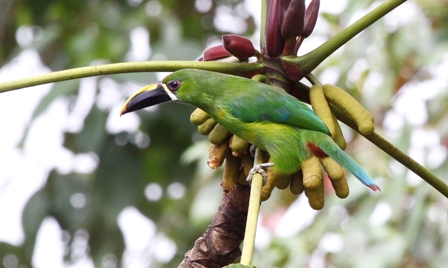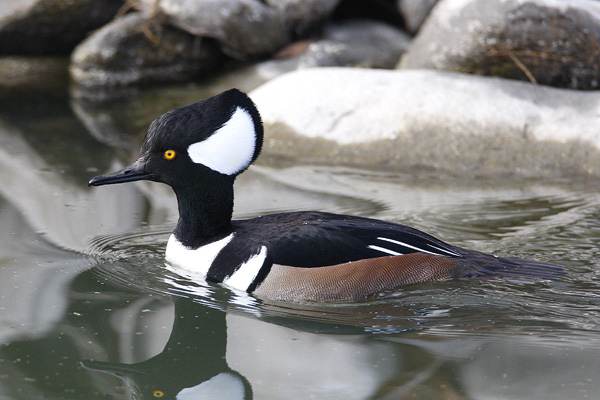Utah County Birders Newsletter
|
 |
Contents
March Meeting
Upcoming Field Trips
President's Message
Bird of the Month
Field Trip Report
- Farmington Bay & Lee Kay Ponds
Field Trip Report
- Salt Lake County
Field Trip Report
- Delta Snow Goose Festival
Backyard Bird of the Month
February Hotline Highlights
MARCH MEETING:
Thursday, March 8th, 2012
Our March meeting will be the showing of the movie: THE
BIG YEAR - with Steve Martin, Jack Black, and Owen Wilson. It will be
a fun and relaxing evening. Don't be late, the film is 95 minutes long so we'll
need to start promptly.
Meet at 7:00 PM in the Bean Museum Auditorium on the BYU Campus.
Beginning birders are welcome.
Saturday March 10, 2012
Powder Mountain,
Ogden Valley Hotspots
led by Keeli Marvel. 7:30am-early afternoon. Meet at the American Fork Main
Street Park and Ride (on the west side of I-15 off Pioneer Crossing) at 7:30 am.
Weather dependent. If the weather is bad, we will stay in the county.
Saturday March 24, 2012
Juab County
led by Bryan Shirley. Meet at 7am at the Payson Walmart. This will be a half
day field trip to various hot spots in Juab County.
Saturday March 31, 2012
Sanpete County
Hotspots led by
Oliver Hansen. Meet @ 7:30am - Payson Walmart. Half a day trip to various
habitats in Sanpete County to help people complete another county for the
UCB 2012 Challenge.
We are actively recruiting people to lead local half-day field trips, any time,
any place. If you would like to lead a field trip or if you have any ideas for
this year’s field trips, please contact Keeli Marvel at - keeli.marvel@gmail.com.
by Bryan Shirley, UCB President
 |
 |
|
Santa Marta Toucanet |
Island Birding in Columbia
When conditions are right, islands produce endemic birds. Islands have to be far
enough away from the mainland to prevent most birds from reaching there, but
close enough that occasionally one will. Once a population of birds is finally
established on an island they change, or evolve, to fit the environment. The
most famous example is of course the Galapagos and the finches found there, but
the same thing has happened, or is happening, on islands around the world.
Last month I was lucky enough to visit an “island” full of endemics in Columbia.
This island is not an island in the regular sense, but an island in the desert.
The Andes come north into Columbia, but peter out long before reaching the
northern coast. The habitat becomes hot and dry, creating a northern boundary
for all of the species that live in the cool, moist Andes. For those species
this desert is just as uninhabitable as the ocean and the mountains in the
middle of it are an island. Sometime in the past, some birds somehow managed to
make it there. Just like on islands they were an isolated population cut off
from the rest of their species and overtime evolved into completely different
species.
If you go through a Columbia bird book or birds of the world book, you are going
to find a lot of birds that start with “Santa Marta”. There is the Santa
Marta Toucanet, the Santa Marta Brush-Finch, the Santa Marta Parakeet, and a lot
more. In all there are 19 species endemic to these mountains (and a couple more
that everybody agrees should be a new species but are still waiting to be
described). Most are relatively easily seen, but of course there are a few
tough
ones as well.
The typical birding trip here involves a 2-3 hour drive up a pretty rough dirt
road to El Dorado Lodge. The lodge has a bunch of hummingbird feeders and a few
bananas to attract tanagers and other small birds. There are many trails around
the lodge, but most of our birding was along the dirt road. Like the Andes,
certain species are found only at certain elevations. Two mornings we left in
the dark and drove about an hour up the road and birded there, while other times
we drove several miles below the lodge and birded there as well. It was great
birding everywhere.
One of the highlights was seeing 3 Antpitta species in one day, including the
endemic Santa Marta Antpitta. Every evening one of the lodge employees takes a
few worms and feeds the Santa Marta Antpitta just below the lodge so that one
was easy. The other 2 species, Rufous Antpitta and Rusty-breasted Antpitta, were
a lot more work. The Rufous even involved crawling into a thick patch of bamboo
and waiting for a glimpse.
With all the Santa Marta endemics and then a couple of days in the desert as
well I ended up seeing 50 lifers and had an awesome trip.
 |
|
Photo by Jack Binch |
Hooded Merganser (Lophodytes cucullatus)
by Carol Nelson
I love birding! It can cause my excitement to soar especially when I see the
unexpected in my yard. I remember my thrill when I first sighted a Bald Eagle in
my back yard on a Christmas day a few years ago. My excitement was just as high
in the years that followed when I saw the Northern Goshawk perched in a big
Cottonwood, Lewis’s Woodpecker sitting on our telephone pole, and a Eurasian
Wigeon floating solo in the middle of the golf course pond behind our house then
foraging under my feeders. There is much to be said about picking up a pair of
binoculars and taking the opportunity to look out our windows.
This year I had another wonderful gift. When I picked up my binoculars to look
at what my poor eye sight thought was a Bufflehead, I was shocked to see a male
Hooded Merganser. Last year the female showed up for the first time, but I spent
the winter wishing she were a male. My wish came true this year. Her more
gorgeous partner has been almost a daily visitor since just before Christmas,
and has been frolicking on the pond as I have been reading about him today.
The Hooded Merganser is a North American bird and the smallest of the three
species we enjoy here. They are also known as saw-bills or fish-ducks. When I
showed a picture to a golfing friend and he said it was a pretty fancy looking
duck, I told him it wasn’t a duck, it was a merganser. Reading has proved me
wrong. A merganser is a duck, but a duck with a very slender, elongated,
serrated bill, tipped with a hooked nail. A large part of their diet is fish and
the bill is ready made for capturing and controlling the slimy creatures. They
also eat frogs, mud crabs, clams, crustaceans, especially crayfish, and aquatic
insects, the insects being especially important to the feeding of the young.
Mergansers locate their prey visually while swimming on shallow ponds with their
faces submerged.
The female and the non breeding male look very much the same. They are dusky
brown with reddish brown in the crest. The female looks like she has just stuck
her bill in a light socket. Her bristly crest looks like it would be great for
scrubbing pans. In breeding the male has rufous flanks, a white breast with two
black stripes intercepting it near the neck, a golden eye and a black back and
head surrounding the white fan-like crest, which when opened gives the merganser
a huge high forehead.
Mergansers are very agile swimmers, but are awkward on land because their legs
are set well back on their bodies. In flight, according to Sibley, they have
very fast and shallow wing beats and seem to be flying with their wing tips.
Their wings produce a high cricket like trill in flight, loudest in adult males.
One of the most common courtship behaviors of the male is the “Head-Throw.” “A
male raises his crest and swims parallel to a female. He throws his head back
sharply until it touches his back and then brings it forward slowly while
emitting a rolling frog-like croak.” I don’t know, ladies. Do you think that
would do anything for you?
They start breeding at the age of two and nest in cavities 10 to 50 feet up a
tree. The female plucks “down” from her “brood patch” to line the nest. She lays
10 -12 white eggs and incubates them alone for 29-33 days. Within 24 hours of
their hatching, the ducklings are called forth from the nest. The ducklings use
sharp claws to reach the top of the cavity then drop to the ground. They are
then taken to the safety of the water. They don’t need a mother to feed them or
teach them to swim, in fact although the female does tend them and leads them to
areas where they can find food, she leaves them on their own before they can
fly.
The Hooded Merganser is a beautiful creature and truly a fine sight seen through
a pair of binoculars out your kitchen window. OK, if truth be told, it’s a
beautiful sight anyplace. (If you have a pond but no Merganser and would like to
have one, you can purchase a courting Hooded Merganser decoy off the internet
for a miserly $140.00. Then on days when your head is not so clear and neither
is your eye sight, you may be able to convince yourself it’s the real thing.)
Information comes from Cornell, The Smithsonian National Zoological Park, and
various field guides.
If you would like to
write an article for the Bird of the Month, please contact Oliver Hansen --
801-378-4771 -
byucactus@gmail.com
.
Click here for past 'Birds of the Month'.
Field Trip Report
Farmington Bay and Lee Kay Ponds - 4 February 2012
by Jeff Cooper
A group of twenty-one seasoned and beginning birders joined a Utah County
Birders-sponsored field trip this morning and made the drive up to Farmington
Bay and Lee Kay Ponds. The weather was awesome for a winter day with clear skies
and lots of sunshine. As always, the company was great, finding birds was fun,
and seeing the excitement on the faces of new birders was a delight.
We observed fewer species than hoped at Farmington Bay (30), but got great looks
at 12 juvenile Black-crowned Night Herons in the phragmites west of the
dike at one of the bridges. Several of them were initially visible from the
bridge as they stood at the edge of the water and phragmites. Everyone in the
group got good looks at the birds standing then flying from the phragmites.
Amazingly, one or two other herons would fly from within the phragmites every
few minutes and circle the area until all 12 flew off in the distance. Some
wintering White-faced Ibis flew by about the same time. Very few Bald
Eagles were seen today and most of the gulls and ducks were on the far east
edge of the bay. We did not locate the limping Western Gull today. We did get
good looks at a large group of Tundra Swans.
We did a quick pass of Glover Ponds on the way out and spotted at least two Richardson's
Cackling Geese.
Lee Kay ponds added another 12 species to our list for a total of 42 for the
day. The surprise there was a lone Double-crested Cormorant that flew
overhead. What a strange winter this has been with summer birds wintering in
Utah. The few gulls on the ponds were all California and Ring-billed.
Surprisingly, none were Herring. We saw hundreds of gulls over the dump in the
distance, but very few on the ponds today. We observed at least seven duck
species and the Male Buffleheads and Hooded Mergansers were a treat for
many in the group.
Thanks to all who joined the trip today and happy birding to the rest of our
readers.
Field Trip Report
Salt Lake County - 18 February 2012
by Keeli Marvel
Utah County birders met Saturday morning to bird several locations in Salt Lake
County. Stops included: Lee Kay Ponds, Decker Lake, Redwood Trailhead Park,
Wheeler Farm, and the Sandy City Fishing Pond. Best birds of the field trip were
several raptor species sighted at Lee Kay ponds including Rough-legged Hawk,
Red-tailed Hawk, Prairie Falcon, and Peregrine Falcon. At
other stops throughout the trip we also picked up several American Kestrels,
and we rounded out our raptor count for the day with a Sharp-shinned Hawk
flying over the Sandy City Fishing Pond. We'd hoped for a Barrow's Goldeneye,
but were unable to locate one at any of the stops. A complete list of species
seen at each stop is below.
Lee Kay Ponds, Salt Lake, US-UT
Canada Goose 12
Gadwall 2
American Wigeon 1
Mallard 20
Canvasback 2
Redhead 5
Ring-necked Duck 50
Bufflehead 2
Pied-billed Grebe 1
Northern Harrier 3
Red-tailed Hawk 1
Rough-legged Hawk 3
Peregrine Falcon 1 Seen by a few in the group.
Prairie Falcon 1 Seen by a few in the group.
gull sp. 100 Flying over landfill. Too far away for identification.
Black-billed Magpie 1
Common Raven 2
Horned Lark 1
European Starling 100
Song Sparrow 2
White-crowned Sparrow 30
Red-winged Blackbird 1
Western Meadowlark 1
Brewer's Blackbird 1
Lake Park, Salt Lake, US-UT
American Kestrel 2
Rock Pigeon 1
Decker Lake, Salt Lake, US-UT
Graylag Goose (Domestic type) 10
Canada Goose 29
Mute Swan 1
Mallard 10
Mallard (Domestic type) 30
Northern Shoveler 10
American Coot 20
Ring-billed Gull 1
California Gull 1
gull sp. 20
Black-billed Magpie 1
Redwood Trailhead Park, Salt Lake, US-UT
Pied-billed Grebe 1
American Coot 6
Northern Flicker 2
Black-billed Magpie 2
American Robin 4
Song Sparrow 1
House Sparrow 3
Wheeler Farm, Salt Lake, US-UT
Graylag Goose (Domestic type) 10
Canada Goose 30
Mallard 10
Mallard (Domestic type) 50
Rock Pigeon 100
Black-capped Chickadee 10
American Robin 6
Sandy Fishing Pond, Salt Lake, US-UT
Mallard 15
Mallard (Domestic type) 20
Redhead 2
Lesser Scaup 1
Pied-billed Grebe 10
Sharp-shinned Hawk 1
American Coot 20
American Robin 1
Field Trip Report
Delta Snow Goose Festival - 25 February 2012
by Oliver Hansen
Several cars worth of Utah Co. birders (about 15 people) made their way out to
the Snow Goose Festival today. We birded at Gunnison Bend reservoir, Clear Lake
WFMA, and the small reservior marked on google maps as DMAD reservoir. We found
a "small" flock of maybe 3-4 thousand SNOW and ROSS'S GEESE early in the
morning in some fields outside of town. Most of the access/dike roads in Clear
Lake were closed for the season, but we did drive around to a few different
spots and find a few flocks of waterfowl. By the time we got back into town and
had some lunch, the SNOW GEESE had found their way to Gunnison Bend and a
very nice lady with property right on the east side of the Lake let us walk down
to the shore and get some amazing views of what I estimated to be 12-13 thousand
SNOW GEESE including a few of the blue morph type.
I personally saw about 35 different species for the day and added a few new
county birds to my Millard Co list. Not quite enough for the "expert level" for
our Utah County Birders 2012 challenge, so some of us might want to think about
heading back out there in the spring/summer to get some shorebirds and
songbirds.
Some other highlights for me (besides the geese and good company) included
seeing 10 SANDHILL CRANES near Lynndyl, Ut on the way into Delta. I saw 2
CRANES on the way out at the same location in the afternoon. Another was
a flyover PRAIRIE FALCON at Clear Lake WMA. Another was a beautiful fly
over ROUGH LEGGED HAWK in the canyon just W. of Nephi on HWY 132. Great
day. Another find that came up as a seasonal rarity in ebird was the handful of
CINNAMON TEAL we saw at Clear Lake WMA.
Notice how I didn't mention the horrible winds we had today. I'm trying to
forget about the only bad part of the day =).
February 2012
Dennis Shirley - Elk Ridge
A pair of Great Horned Owls calling during the night from our house roof
top.
Alton Thygerson - Provo
Nothern Flicker - a periodic visitor searching for food (suet and seed).
Steve Carr - Holladay
Pine Siskin - Only one individual this whole winter, despite lots of
American and Lesser Goldfinches.
Eric Huish - Pleasant Grove
Merlin - Executed some fast-flying, high-speed maneuvers chasing House
Finches then Starlings over the yard.
Milt Moody - Provo
I finally got some Pine Siskins to show up at my thistle feeder.
Reed Stone - Provo
Several Yellow-rumped Warblers, Ruby-crowned Kinglet - always nice to see
them.
Carol Nelson - Provo
The Hooded Merganser still occasionally dabbles around in the pond and
was joined one day by a Great Blue Heron. An adult Bald Eagle was
also a welcome visitor.
Cheryl Peterson - Provo
Female Cassin's Finch and several Pine Siskins and American
Goldfinches.
2012 Dues
Thanks to all who have supported us in the past. If you are interested in officially joining us this year, make out a check to Utah County Birders for $15.00 and mail it to:
Carol Nelson
2831 Marrcrest West
Provo, Utah 84604
You will be helping to support the web page and we will send you a copy of the newsletter.